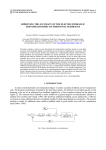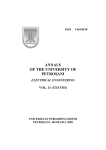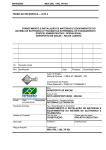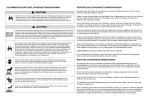Download THE USER'S GUIDE FOR THE AUTHORS
Transcript
SISOM 2006, Bucharest 17-19 May PROGRAMMING METHOD OF THE MAINTENANCE ACTIVITIES OF THE PROCESS EQUIPMENT Marius Gabriel PETRESCU, Ion NAE Petroleum-Gas University of Ploiesti The paper presents the compulsory relation between the volume of the maintenance operations and the accepted risk level, though offering a managerial tool for scheduling and observing the operation and maintenance activities. Key words: maintenance, risk, Key managerial tool. 1. INTRODUCTIVE NOTIONS On the grounds of the superior capitalization of the raw material it was determined the increase of the equipments’ complexity, the intensification of the work regime (temperatures, pressure, speed etc.), the increase of the installations’ automation degree, the increase of the machines’ and installations’ value and also the risks concerning their damage. As a result, the main objective to whom there are in subordination the designing, the execution, the installation, the exploitation, the repairing and the check of the process equipments is the assurance of their functioning (in good conditions) without damages, during the entire period of time foreseen for their use. That is why at the same time with the production planning it has to take into consideration as an essential condition the planning of the maintenance and equipments repairing activities. A very correct managerial activity has to establish an optimum between the maintenance operations volume and the accepted risk level. The classification of the creeps and their production mechanisms is realized on the grounds of the mentions made in the observation papers of the equipment work as it is presented in the tables 1 and 2. Table 1. Classification of the creeps taking into account the severity degree Type of creep Appreciation Critical - which causes immediate and complete loss of the system’s capacity. Incipient - which has not an immediate effect on the equipment work. With degradation in time - which does not produce the immediate and complete fall of the equipment, but it compromises its correct work. With unknown degree of severity - unforeseen events or events that do not endanger the equipment work. For simplification it is recommended the classifications of the creeps in two distinct categories: critical and non-critical. It is accepted in the damage non-critical category to be included those who are incipient and those with degradation in time. Also, in the maintenance activities there are taken into consideration two typical creep mechanisms: by damage, manifested by amplification in time of the wear phenomenon which in the absence of maintenance activities may generate critical creeps; instantaneous (suddenly or by choc), manifested aleatory from the point of view of time without visible degradations before the creep. The classification of the creeps (critical or non – critical) is realized mainly by identification of the methods that were as base of their detection. The detection produces in different conditions as it follows: during the development of the preventive maintenance activities – these are made periodically and consist in 381 Programming method of the maintenance activities of the process equipment the check of the device’s working condition, the testing of the susceptible damaging elements and replacement of the damaged parts; by aleatory observations, which have accidental character in detection of the eventual creeps (it is based on observation and accidental control of the operator mainly); by observation/monitoring – in this case the creep is observed on the basis of indications/signaling of the measuring and control device that supervises the process. Table 2. Mechanisms specific to the creep Type of creep Mechanism specific to creep By degradation - mechanical wear; - vibrations/oscillations; - material defect; - trybological defects; - contamination of the product; - wrong operation parameters; Instantaneous - electrical damage; - damaged measuring devices; - lack of process signaling; - damage alarm. The pursuit of the equipments work and the registration with maxim accuracy of the data concerning their damages offers the possibility of optimizing the volume of maintenance operations using statistical methods. In the industrial practice it is accepted a classification of the maintenance operations in three categories: - Preventive maintenance (MP), having as purpose to prevent the creeps due to the wear; - Inspections made in order to reduce the catastrophic consequences of the creeps; - Predictive maintenance, consisting in the detection of the deviations of some functional parameters from the nominal values and taking the measures needed for the prevention of the some damages that leads from it. Specialty literature and practical experience in the field of the functional analysis of the systems recommends the use of the Weibull bi-parametrical models in the appreciation of the equipments’ reliability and maintenance. 2. ESTIMATION OF THE MAINTENANCE INTERVALS AT THE PROCESS EQUIPMENTS In the following it is considered that the work of an equipment supposes the following simplifying methods: instantaneous critical creeps and the critical ones due to the degradation could not appear in the same time; the instantaneous (sudden) creeps are considered to have a constant appearance rate λI no matter if the studied system presents a degradation state due to the wear; the repaired components are assimilated with the new components; the non – critical creeps may be totally detected by actions of preventive maintenance (MP), aleatory observation (OA) or alarm (A); the average of the total time of repairing (MTTR) are considered having smaller values in comparison with the work duration and may be neglected; there will be considered important only those instantaneous creeps that are critical; the non-critical instantaneous creeps are ignored; all the calculus are reported at operational time lengths. The modelling of the creeps is realized with the help of a state diagram (Figure 1) in which the system’s state gets the significations presented in table 3. Such a representation is based on Markov processes in order to analyze the system’s evolution rendered by the states occupied in different moments of time. As it follows from the Figure 1, different possible states of the system are tied between them by so-called transfer rate (failure rate corresponding to the types of the respective creeps) which, here, have the signification of failure rates. The use of the processes type Markov in order to estimate the operational reliability of the system supposes the adoption of some transfer rate with constant value in time. This hypothesis allows doing pertinent analysis also in situations in which for the studied system it does not dispose of statistical data enough for the modelling of the creeps’ distribution in time. 382 Marius Gabriel PETRESCU, Ion NAE Table 3. Significations of the system states State Signification OK - The system is in working condition; new system; Instantaneous, Critical - The system is in non-working condition due to a critical creep; Degradation, Non-critical - The system is in the course of degradation in what it concerns the functions; system still not functional; MP - During the preventive maintenance activities (MP) there was detected a non-critical creep; Degradation, Critical - The system is still in non-working condition due to a critical degradation; Aleatory observation - The detection of a non-critical creep by the surveillance personnel or their signaling by the installation’s alarm systems. Instantaneous critical creep Non-critical creeps Critical creep Aleatory observation Figure 1. State diagram of the considered system The effective preventive maintenance interval is: τMPe = τMP τop/τs (1) where the lengths τMP, τop, τs are expressed in time units and represent: τMP – time length between two consecutive stops dedicated to preventive maintenance; τop – equipment operation total length; τs – surveillance total length. The numerical values of the transfer rate are established starting from the time length elapsed from the finding of a non-critical creep till the immediate following preventive maintenance action have an average value equally to τ/2 (where τ represents the time length between two consecutive stops dedicated to preventive maintenance activities). In these conditions, the failure rate due to the preventive maintenance operation is: λMP = 2/τMPe (2) 383 Programming method of the maintenance activities of the process equipment Reporting to the relation 2 there may be established the values corresponding to the failures rates due to the type of damage as it follows: - For stops due to the non-critical damages detected by an aleatory observation: λA = λMP nA,NC/ nMP,NC (3) where: nA,NC represents the number of the non-critical creeps detected by aleatoy observation; in this category are included also the creeps signaled by observation or monitoring; nMP,NC – the number of the stops due to preventive maintenance operations in order to eliminate the non-critical damages. - For stops due to the critical damages which have as basis degradation phenomena: λD,C = λMP nD,C/ nMP,NC (4) where nD,C represents the number of the critical creeps due to technical state degradation. - For stops due to some instantaneous damages (suddenly appeared considered critical) it is used the calculus relation recommended in the papers [1, 6, 8, 9]: λI = nI/ τs (5) where nI represents the total number of stops due to instantaneous damages. Using this algorithm there may be established the failure rates specific to different creep ways corresponding to a pre-established maintenance interval τ. 3. CALCULUS EXAMPLE It is considered the case of an equipment for which there are known: τop = 3,60 years; τs = 5,94 years; τMP = 0,50 years and the details of the creeps according to the data from the observation papers – table 4. Interval MP, months Creep detection method 6 Preventive maintenance Aleatory observations Alarm/monitoring Others Table 4. Details of the equipment creeps Non-critical creeps Critical creeps Instantaneous By degradation Instantaneous By degradation II I II Nnc Nnc Nc NcI 51 1 0 0 2 0 0 0 21 3 10 2 0 0 0 0 Total creeps 52 2 36 0 Using these data there are obtained for the failure rates the following values: λA = 3,01 stops/year; λD,C = 1,31 stops/year; λI = 0,67 stops/year. If it is considered that the critical creeps are uniformly distributed on the equipment work periods and an accidental constant failure rate λI it may be graphically represented the variation of the failure rate depending on the maintenance interval size at it may be seen in the Figure 2. 4. CONCLUSIONS On the grounds of the graphical representations from the figure 2 there may be established an optimal value for the preventive maintenance interval (τMP) taking into account the creeps’ volume corresponding to the total failure rate with minimal value. In the case of the studied equipment as it follows also from the Figure 2 it is recommended to do the specific interventions of preventive maintenance activities in an interval of 12 months (according to the graphical representations from the Figure 2 in which the stops rate due to the preventive maintenance actions is the factor that limits the time interval in which it is manifested an acceptable number of critical creeps). Marius Gabriel PETRESCU, Ion NAE 384 Figure 2. The influence of the maintenance interval size on the failure rate, for the compression subsystem In order to establish the optimum maintenance interval, besides the failure rate, it is recommended to take into account also the afferent costs of the equipments’ maintenance in the interval of two planned stops, the results obtained having a better economic justification. REFERENCES 1. BARBET, J. F., Les methods d’analyse de la securite des systemes, Revue Generale de Preventation, 30, pp. 42, 1984. 2. CĂTUNEANU, V. M., MIHALACHE, A., Bazele teoretice ale fiabilităţii, Ed. Academiei, Bucureşti, 1983. 3. GNEDENKO B., BELIAEV V., SOLOVIEV A., Methodes mathematiques en theorie de la fiabilite, Moscov, 1972. 4. Masschelein, C. A., Ryder, D. S. And Simon, J. P. Immobilized cell technology in beer production. Crit. Rev. Biotechnol. 14, pp.155-177, 1994. 5. NIŢU. V. ş.a., Fiabilitatea instalaţiilor energetice, Culegere de probleme, Ed. Tehnică, Bucureşti, 1979. 6. ANON, G., Industry analysts focus on US, Asian, Latin American markets, Oil and Gas Journal Special, April 25, pp 45, 1994. 7. BATTEAU, P., MARCIANO, J.P., Probabilite et decision dans l’incertain, PUF, 1976. 8. ANTONESCU, N.N., ULMANU, V., Fabricarea, repararea şi întreţinerea utilajului chimic şi petrochimic, Ed. Didactică şi Pedagogică, Bucureşti, 1981. 9. BARON T., Calitatea şi fiabilitatea produselor, Ed. Didactică şi Pedagogică, Bucureşti, 1976. 10. HELGE S., a.o., Practical experience with a data collection project – The OREDA project, 2002. 11. JØRN V., OREDA Data Analysis - Compressor study, SINTEF Report STF 75 F 92034. 12. KNUT H., PER H., HELGE S., The analysis of failure data in the presence of critical and degraded failures. ESREL ‘95, Bournemouth, 1995. 13. OREDA, Guidelines for Data Collection, 6th edition, 1995. 14. PER, H., ANDERS, T.F., The modelling of degraded and critical failures for components with dormant failures, London, 2000. 15. ROGER, C., The Design of Reliability Data Bases. Part I and II, Cambridge, 2002.












